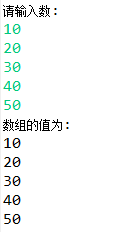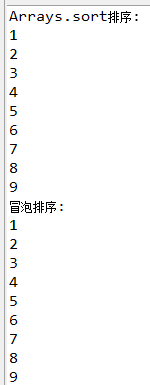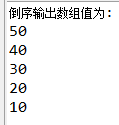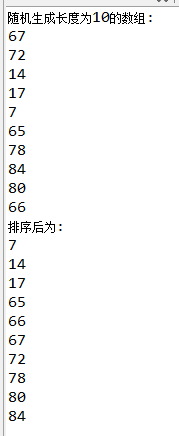第八周作业
1、编写一个简单程序,要求数组长度为5,分别赋值10,20,30,40,50,在控制台输出该数组的值。(知识点:数组定义和创建、一维数组初始化)[必做题]?
package Test5; import java.util.Scanner; public class h1 { /** * @param args */ public static void main(String[] args) { // TODO Auto-generated method stub int a[] = new int[5]; Scanner input = new Scanner(System.in); System.out.println("请输入数:"); for (int i = 0; i < a.length; i++) { a[i] = input.nextInt(); } System.out.println("数组的值为:"); for (int i = 0; i < a.length; i++) { System.out.println(a[i]); } } }

2、将一个字符数组的值(neusoft)拷贝到另一个字符数组中。(知识点:数组复制) [必做题]?
package Test5; public class h1 { /** * @param args */ public static void main(String[] args) { // TODO Auto-generated method stub char a[]={'n','e','u','s','o','f','t','e'}; char b[]=new char[8]; System.arraycopy(a, 0, b, 0, a.length); System.out.println("数组a的值为:"); System.out.println(a); System.out.println("拷贝后数组b的值为:"); System.out.println(b); } }

3、给定一个有9个整数(1,6,2,3,9,4,5,7,8)的数组,先排序,然后输出排序后的数组的值。(知识点:Arrays.sort排序、冒泡排序)
package Test5; import java.util.Arrays; public class h1 { /** * @param args */ public static void main(String[] args) { // TODO Auto-generated method stub int a[] = { 1, 6, 2, 3, 9, 4, 5, 7, 8 }; System.out.println("Arrays.sort排序:"); Arrays.sort(a); for (int i : a) { System.out.println(i); } System.out.println("冒泡排序:"); for (int i = 0; i < a.length - 1; i++) { for (int j = 0; j < a.length - 1 - i; j++) { if (a[j] > a[j + 1]) { int temp = a[j]; a[j] = a[j + 1]; a[j + 1] = temp; } } } for (int i : a) { System.out.println(i); } } }

4、 输出一个double型二维数组(长度分别为5、4,值自己设定)的值。(知识点:数组定义和创建、多维数组初始化、数组遍历)
package Test5; public class h1 { /** * @param args */ public static void main(String[] args) { // TODO Auto-generated method stub double a[][] = new double[5][4]; for (int i = 0; i < a.length; i++) { for (int j = 0; j < a[i].length; j++) { a[i][j] = i; } } for (int i = 0; i < a.length; i++) { for (int j = 0; j < a[i].length; j++) { System.out.print(a[i][j]+" "); } System.out.println(); } } }

5、 在一个有8个整数(18,25,7,36,13,2,89,63)的数组中找出其中最大的数及其下标。(知识点:数组遍历、数组元素访问)
package Test5; public class h1 { /** * @param args */ public static void main(String[] args) { // TODO Auto-generated method stub int a[]={18,25,7,36,13,2,89,63}; int max=a[0]; int number=0; for (int i = 1; i < a.length; i++) { if (a[i]>max) { max=a[i]; } number++; } System.out.println("最大值为:"+max); System.out.println("下标为:"+number); } }

作业
6、将一个数组中的元素逆序存放(知识点:数组遍历、数组元素访问)
package Test5; public class h1 { /** * @param args */ public static void main(String[] args) { // TODO Auto-generated method stub int a[] = { 10, 20, 30, 40, 50 }; int b; for (int i = 0; i < a.length / 2; i++) { b = a[i]; a[i] = a[a.length - i - 1]; a[a.length - i - 1] = b; } System.out.println("倒序输出数组值为:"); for (int i = 0; i < a.length; i++) { System.out.println(a[i]); } } }

7. 将一个数组中的重复元素保留一个其他的清零。(知识点:数组遍历、数组元素访问)
package Test5; public class h2 { /** * @param args */ public static void main(String[] args) { // TODO Auto-generated method stub int a[] = { 10, 20, 30, 40, 50, 30, 10, 40 }; for (int i = 0; i < a.length; i++) { for (int j = 0; j < a.length; j++) { if (a[i] == a[j] && i != j) { a[j] = 0; } } } for (int i = 0; i < a.length; i++) { System.out.println(a[i]); } } }

8、给定一维数组{ -10,2,3,246,-100,0,5},计算出数组中的平均值、最大值、最小值。(知识点:数组遍历、数组元素访问)
package Test5; public class h3 { /** * @param args */ public static void main(String[] args) { // TODO Auto-generated method stub int a[] = { -10, 2, 3, 246, -100, 0, 5 }; int max = a[0]; int min = a[0]; double sum = 0; for (int i = 1; i < a.length; i++) { if (a[i] > max) { max = a[i]; } if (a[i] < min) { min = a[i]; } } for (int i = 0; i < a.length; i++) { sum += a[i]; } System.out.println("最大值为:" + max); System.out.println("最小值为:" + min); System.out.println("平均值为:" + sum / a.length); } }

9、使用数组存放裴波那契数列的前20项 ,并输出 1 1 2 3 5 8 13 21
package Test5; public class h4 { /** * @param args */ public static void main(String[] args) { // TODO Auto-generated method stub int a = 1, b = 1, c = 0; int x[] = new int[20]; x[0] = a; x[1] = b; for (int i = 1; i <= 18; i++) { c = a + b; a = b; b = c; x[i + 1] = c; } System.out.println("输出前8项为:"); for (int i = 0; i < 8; i++) { System.out.println(x[i]); } } }

10、生成一个长度为10的随机整数数组(每个数都是0-100之间),输出,排序后,再输出
package Test5; import java.util.Arrays; public class h5 { /** * @param args */ public static void main(String[] args) { // TODO Auto-generated method stub int a[] = new int[10]; System.out.println("随机生成长度为10的数组:"); for (int i = 0; i < a.length; i++) { a[i] = (int) (Math.random() * 100); } for (int i = 0; i < a.length; i++) { System.out.println(a[i]); } System.out.println("排序后为:"); Arrays.sort(a); for (int i = 0; i < a.length; i++) { System.out.println(a[i]); } } }




